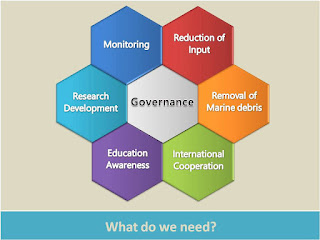來自韓國海洋科技研究院的首席科學家 Won
Joon Shim博士,
也是韓國科技大學的教授。
Shim 教授畢業於首爾大學,發表超過190篇的論文,是海洋垃圾研究領域的佼佼者。
Shim 教授畢業於首爾大學,發表超過190篇的論文,是海洋垃圾研究領域的佼佼者。
此次應邀就海洋微塑膠問題與我們分享有關此議題的嚴重性
*****************************
我們製造的塑膠垃圾終究進到了大海,然後呢?
21世紀初,我們開始注意到我們每日生活中使用的塑膠微例,最後會進入到海洋,而且其數量快速增長。1960年代使用塑料以來,塑膠微粒,或者是從大的塑料品碎裂過程中造成的碎片成為我們的挑戰。塑料微粒幾乎無所不在,從湖泊到大洋,從地表水到深海,以及各水層的生物內。因為分裂後的塑膠微粒體積很小,使得野生動物容易食入。越小粒徑的微塑膠讓小型的海洋生物也能夠輕易攝食。此趨勢讓很多生物體吸收了這些化學物質。正因為它們非常小,使得檢測塑料微粒和評估其有害生物效應都是個很大的挑戰。另外,技術上很難將微塑料顆粒將環境中移除,也使得他們在環境中更持久。目前,如貽貝,牡蠣,龍蝦和魚等都無法倖免於海洋微塑膠污染當中。現在很容易從海鮮當中發現這些塑膠微粒。雖然我們還不確定倘若人類食用這些含有微塑膠的海鮮是否會有化學毒性。不過,這些從我們手中丟棄的塑膠微粒,經過海洋生物,然後回到我們的體內這件事,似乎已經是無可避免的事實。
Revenge of Our Plastics Gone to the Ocean
Global concern over marine plastic
pollution resulting from our end-of-life plastic has grown rapidly since the
presence of microscopic plastic particles in the ocean and an increasing trend
in their abundance were documented in the early 2000s. Microplastics either
engineered or fragmented from large plastic debris in the environment present
different challenges to larger items which have been widely documented since
the 1960s. Microplastics are widely distributed, from lakes to the
open ocean, in surface water and deep sea sediments and in various organisms through the
trophic levels. As large items fragment into
microplastics the abundance of litter increases, and this effectively increases
their availability to wildlife. Furthermore, decreasing particle size increases
the range of organisms that can ingest the debris. Hence smaller plastics
become more bioavailable particularly to small organisms. This increased
surface area increases the potential for leaching or desorption of additive or
adsorbed chemicals to an organism upon ingestion. However, because of their
size detecting the presence of microplastics and adverse biological effects, if
any, becomes considerably more challenging. In addition, the persistence of
plastic particles in the environment can increase because small plastic
particles would be extremely difficult to remove from the environment manually.
Commercial species such as mussels, oysters, lobsters and fish are not free
from marine microplastic pollution. It is currently not hard to find several
pieces of microplastics in some of our seafood stuffs. Although risk of
microplastic ingestion by human being and their contribution to toxic chemical
load to seafood stuffs are still questionable, plastics gone to the ocean from
our hands finally and definitely come back to our mouths.





































沒有留言:
張貼留言